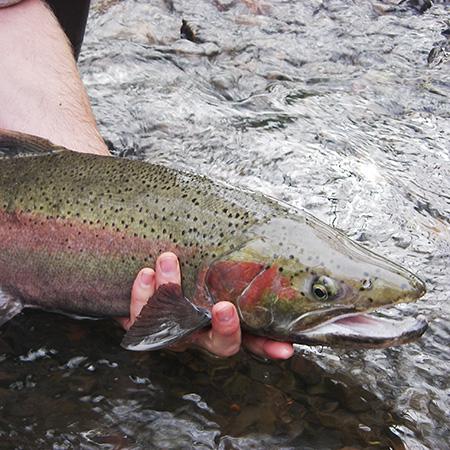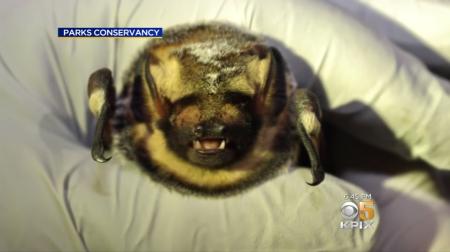Why Was This Indicator Chosen?
Threatened steelhead trout (Oncorhynchus mykiss) in Redwood and Lagunitas creeks are good indicators of riparian habitat and hydrological conditions as well as ocean health, and provide marine-derived nutrients for aquatic and riparian communities.
What is Healthy?
Living in both estuarine and stream habitats that vary in depth, velocity, temperature, and shelter, steelhead are not as dependent on stream habitat conditions for survival as coho salmon. To persist indefinitely, steelhead trout should occupy more locations in the Mt. Tam area of focus and should migrate to the ocean in numbers sufficient to allow a viable number of adult steelhead to return each year and spawn. The National Fish and Wildlife Service recovery plan for this species (NMFS, 2012) lists specific goals for numbers of spawners and redds (nests), and smolts (young fish migrating out to sea).
What Are the Biggest Threats?
- Historic hydrological changes and habitat loss that have affected anadromous fish migration, increased sedimentation, and reduced the number of pools and other critical habitats
- Current hydrological changes and habitat loss including water withdrawals, drought, channel incision, and a loss of downstream floodplain connectivity
- Ocean-related factors such as over-harvesting of salmonids as well as their prey (e.g., sardines) and changes to ocean food webs related to climate change
- Potential invasive aquatic species including exotic mollusks such as New Zealand mud snail (Potamopyrgus antipodarum) and the spread of invasive Japanese knotweed (Fallopia japonica)
- The effects of climate change such as higher water temperatures, longer droughts, more intense rainfall, and disruptions in the ocean food web
What is The Current Condition?
Steelhead trout are in Poor condition. Stream occupancy numbers are low. Steelhead abundance in Lagunitas Creek, if considered independently, would warrant a condition of caution, as at least 100 steelhead redds have been observed in Lagunitas Creek for 11 straight years, with the notable exception of 2016–2017, when only 35 redds were seen. High stream flows that year precluded surveys for most of the winter, but abundant juvenile steelhead in 2017 retrospectively indicated a large run. For Redwood Creek, however, extremely low numbers of steelhead redds indicate a persistently small population. Fewer than 15 redds have been observed in five of the last eight years. One Tam agency biologists believe the Lagunitas Creek target is too high, but conservatively consider the population in Redwood Creek at high risk of extirpation. Similar concerns exist about the smolt target for Lagunitas Creek, and few data exist on steelhead smolt abundance in Redwood Creek.
What is the Current Trend?
The current trend is No Change. Steelhead redd counts remained stable in Lagunitas Creek between 2015 and 2022. In Redwood Creek, average steelhead redd counts, although still low, have increased since 2016, with an eight-year average of 20 redds compared to 2016, in which the eight-year average was 10 redds.
How Sure Are We?
We have only Moderate confidence in these assessments because surveys miss certain time periods and stream segments. Also, steelhead trout tend to migrate to and from the ocean in late winter when stream flows can be high. As a result, there remains a fair amount of uncertainty about the condition and trends of our local steelhead populations.
What is This Assessment Based On?
- NMFS Federal Register documents (NMFS 2012, 2015)
- National Park Service inventory and annual monitoring (Carlisle et al., 2016)
- Marin Municipal Water District annual monitoring reports (see MMWD link in References below)
- Redwood Creek Watershed Assessment (Stillwater Sciences, 2011)
What Don’t We Know?
Key information gaps include:
- Expanded monitoring would help build a more robust dataset for steelhead trout, including Passive Integrated Transponder (PIT) tagging to provide data on steelhead trout smolt emigration prior to the start of smolt trapping and field surveys to fully identify both current occupancy and migration barriers
- Further definition of metrics describing pool habitat availability
resources
Bay Area Open Space Council [BAOSC]. (2019). The conservation lands network 2.0 [Report]. https://www.bayarealands.org/maps-data/
California Department of Fish and Wildlife [CDFW]. (2016). Redwood Creek coho salmon rescue and captive rearing project. https://www.wildlife.ca.gov/Drought/Projects/Redwood-Creek-Coho
California Regional Water Quality Control Board, San Francisco Bay Region [CRWQCB]. (2014). Lagunitas Creek watershed sediment TMDL. https://tinyurl.com/yvy9fyrm
Carlisle, S., & Reichmuth, M. (2015). Long-term monitoring of coho salmon and steelhead trout during freshwater life stages in coastal Marin County: 2013 annual report (Natural Resource Report, NPS/SFAN/NRR—2015/956). National Park Service. https://irma.nps.gov/DataStore/Reference/Profile/2221853
Carlisle, S., Reichmuth, M., & McNeill. B. (2016). Long-term monitoring of coho salmon and steelhead trout during freshwater life stages in coastal Marin County: 2014 annual report (Natural Resource Report. NPS/SFAN/NRR—2016/1142). National Park Service. https://irma.nps.gov/DataStore/DownloadFile/546839
Ettlinger, E. (2017). Lagunitas Creek salmonid habitat: 2016. Marin Water.
Ettlinger, E., Andrew, G., Doughty, P., & Rogers, V. (2015a). Adult salmonid monitoring in the Lagunitas Creek watershed: 2014–2015. Marin Water.
Ettlinger, E., Doughty, P., Rogers, V., & Andrew, G. (2015b). Smolt monitoring in the Lagunitas Creek watershed: 2015. Marin Water.
Ettlinger, E., Howe, J., & Sherman, J. (2021). Adult salmonid monitoring in the Lagunitas Creek watershed: 2020–2021. Marin Water. https://tinyurl.com/5bed2zpw
Ettlinger, E. Koehler, J., Cox, E., & Joe, K. (2023). Smolt monitoring in the Lagunitas Creek watershed: 2022. Marin Water. https://tinyurl.com/4vj9wu5x
Ettlinger, E., Ruiz, E., Hossfeld, D., & Andrew, G. (2016). Juvenile salmonid monitoring in the Lagunitas Creek watershed: 2015. Marin Water.
Ettlinger, E., Schleifer, B., & Andrew, G. (2013). Lagunitas Creek salmonid habitat: 2011. Marin Water.
Kar, S., Sangem, P., Anusha, N., & Senthilkumaran, B. (2020). Endocrine disruptors in teleosts: Evaluating environmental risks and biomarkers. Aquaculture and Fisheries, 6(1), 1–26. https://doi.org/10.1016/j.aaf.2020.07.013
Marin Water. (2011). Lagunitas Creek stewardship plan. https://tinyurl.com/56asd75h
Marlatt, V. L., Leung, T. Y. G., Calbick, S., Metcalfe, C., & Kennedy, C. (2019). Sub-lethal effects of a neonicotinoid, clothianidin, on wild early life stage sockeye salmon (Oncorhynchus nerka). Aquatic Toxicology, 217, 105335. https://doi.org/10.1016/j.aquatox.2019.105335
Moyle, P. B., Israel, J. A., & Purdy, S. E. (2008). Salmon, steelhead, and trout in California: Status of an emblematic fauna. Prepared for California Trout. https://tinyurl.com/y6dpx7f9
National Marine Fisheries Service [NMFS]. (2012). Recovery plan for the evolutionarily significant unit of central California coast coho salmon (Vol. 1). https://repository.library.noaa.gov/view/noaa/15987
National Marine Fisheries Service [NMFS]. (2015). Recovery plan for north central California coast recovery domain: California coastal chinook salmon, northern California steelhead, central California coast steelhead (Draft).
Pierce, D. W., Kalansky, J. F., & Cayan, D. R. (2018). Climate, drought, and sea level rise scenarios for California’s fourth climate change assessment (Publication no. CCCA4-CEC-2018-006). Prepared for California Energy Commission. https://tinyurl.com/4hu6r6uh
Quinn, T. P. (2005). The behavior and ecology of Pacific salmon and trout. University of Washington Press.
Ross Taylor & Associates. (2003). Marin County stream crossing inventory and fish passage evaluation. Prepared for the County of Marin, Department of Public Works. https://tinyurl.com/9utcfefe
Schindler, D. E., Hilborn, R., Chasco, B., Boatright, C. P., Quinn, T. P., Rogers, L. A., & Webster, M. S. (2010). Population diversity and the portfolio effect in an exploited species. Nature, 465, 609–612. https://doi.org/10.1038/nature09060
Stillwater Sciences. (2008). Lagunitas limiting factors analysis; Limiting factors for coho salmon and steelhead (Final report). Prepared for Marin Resource Conservation District. https://calisphere.org/item/ark:/86086/n2154g1r/
Stillwater Sciences. (2011). Redwood Creek watershed assessment (Final report). Prepared for Golden Gate National Recreation Area. https://www.nps.gov/goga/learn/management/upload/RCWA_FINAL.pdf
Tian, Z., Zhao, H., Peter, K. T., Gonzalez, M., Wetzel, J., Wu, C., Hu, X., Prat, J., Mudrock, E., Hettinger, R., Cortina, A. E., Biswas, R. G., Kock, F. V. C., Soong, R., Jenne, A., Du, B., Hou, F., He, H., Lundeen, R., … Kolodziej, E. P. (2020). A ubiquitous tire rubber–derived chemical induces acute mortality in coho salmon. Science, 371(6525), 185–189. 10.1126/science.abd6951
Torregrosa, A., Flint, L. E., & Flint, A. L. (2020). Hydrological resilience for summertime fog and recharge: A case study for coho salmon recovery planning. Journal of the American Water Resources Association, 56(1), 134–160. https://doi.org/10.1111/1752-1688.12811
Urgenson, L. S. (2006). The ecological consequences of knotweed invasion into riparian forests [Unpublished master’s thesis]. University of Washington. https://tinyurl.com/2zfb6k2h
Vinson, M. R., & Baker, M. A. (2008). Poor growth of rainbow trout fed New Zealand mud snails Potamopyrgus antipodarum. North American Journal of Fisheries Management, 28(3), 701–709. https://doi.org/10.1577/M06-039.1




